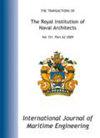高速穿波双体船正常运行疲劳评估
IF 0.6
4区 工程技术
Q4 ENGINEERING, MARINE
引用次数: 3
摘要
在设计过程中对疲劳寿命的估计对于重量优化的船舶(如高速铝船)尤为重要,但到目前为止,还没有关于大型穿波双体船疲劳积累的研究发表,主要集中在长期运行上。本文从疲劳设计的角度评价了船级社规则对高速双体船的适用性。这是通过比较在加那利群岛运行的111米长穿波双体船渡轮和交付航行期间测量的长期应力分布,以及使用DNV船级社接受的方法估计的载荷谱来实现的。本文还提出了一种改进的分布拟合疲劳分析方法。提出了一种将时域内实测应力历史转换为合适的应力谱和威布尔参数拟合的详细方法。结果表明,船级社所接受的简化方法与基于实测数据的疲劳估计结果相比,具有较高的保守性。提出的联合威布尔拟合方法大大提高了简化疲劳分析方法的精度。本文章由计算机程序翻译,如有差异,请以英文原文为准。
Fatigue Estimation on a High-Speed Wave Piercing Catamaran During Normal Operations
The estimation of fatigue life in the design process is particularly important for weight-optimised ships such as high-speed aluminium craft, but to date no research has been published on the fatigue accumulation on large wave-piercing catamarans, focusing on long-term operations. This paper assesses the applicability of classification society rules for high-speed catamarans with respect to fatigue design. This was achieved by comparing the long-term distributions of stress, measured on a 111m long wave-piercing catamaran ferry whilst operating in the Canary Islands and during the delivery voyage, with load spectra estimated using a method accepted by the classification society, DNV. The paper also proposes an improved distribution fitment method for fatigue analysis. A detailed method to convert measured stress histories in the time domain into an appropriate stress-spectrum and fitment of Weibull parameters is presented. Results show that the simplified method accepted by the classification society is highly conservative regarding fatigue estimation compared to fatigue results based on measured data. The proposed combined Weibull fitment method substantially improves the accuracy of simplified fatigue analysis methods.
求助全文
通过发布文献求助,成功后即可免费获取论文全文。
去求助
来源期刊

International Journal of Maritime Engineering
ENGINEERING, MARINE-
CiteScore
1.20
自引率
0.00%
发文量
18
审稿时长
>12 weeks
期刊介绍:
The International Journal of Maritime Engineering (IJME) provides a forum for the reporting and discussion on technical and scientific issues associated with the design and construction of commercial marine vessels . Contributions in the form of papers and notes, together with discussion on published papers are welcomed.
 求助内容:
求助内容: 应助结果提醒方式:
应助结果提醒方式:


